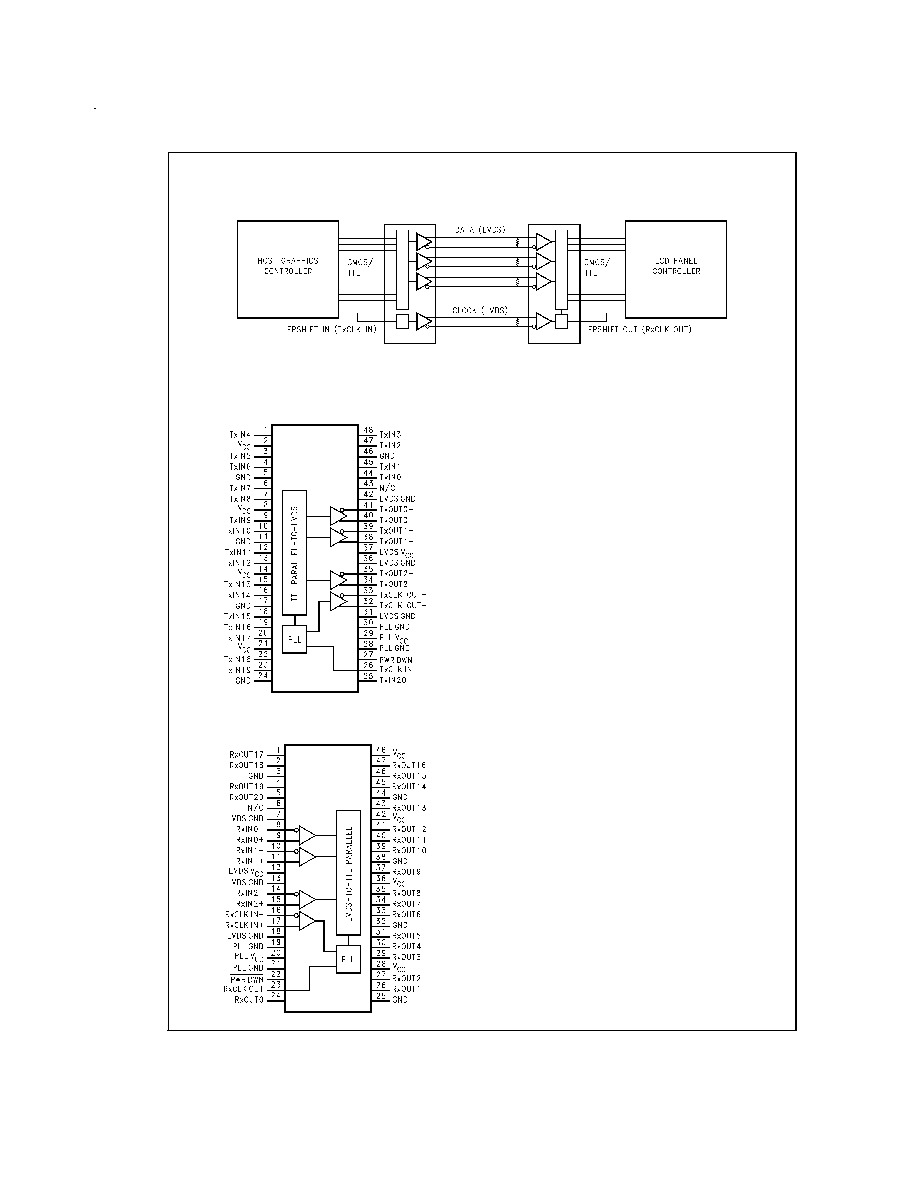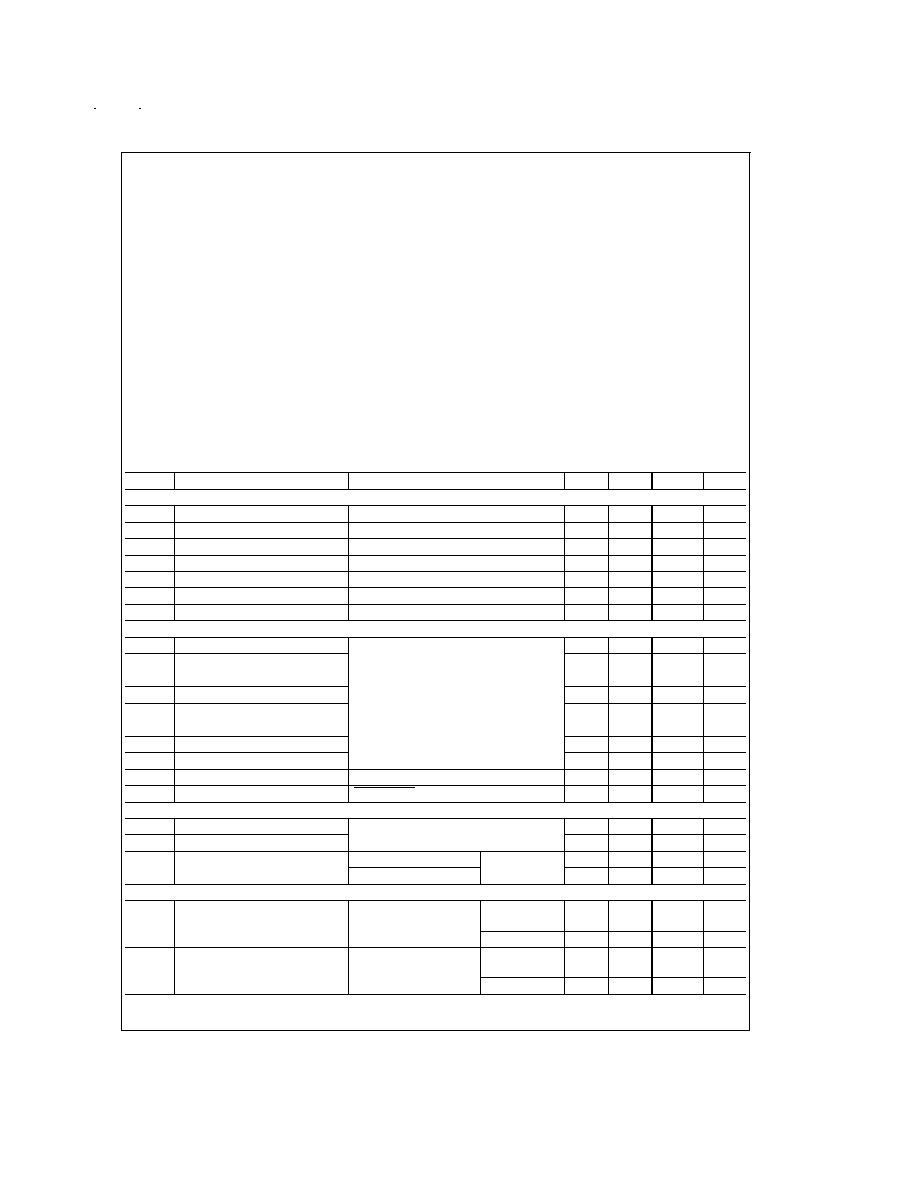 | –≠–ª–µ–∫—Ç—Ä–æ–Ω–Ω—ã–π –∫–æ–º–ø–æ–Ω–µ–Ω—Ç: DS90CF561 | –°–∫–∞—á–∞—Ç—å:  PDF PDF  ZIP ZIP |

DS90CF561/DS90CF562
LVDS 18-Bit Color Flat Panel Display (FPD) Link
General Description
The DS90CF561 transmitter converts 21 bits of CMOS/TTL
data into three LVDS (Low Voltage Differential Signaling)
data streams. A phase-locked transmit clock is transmitted in
parallel with the data streams over a fourth LVDS link. Every
cycle of the transmit clock 21 bits of input data are sampled
and transmitted. The DS90CF562 receiver converts the
LVDS data streams back into 21 bits of CMOS/TTL data. At
a transmit clock frequency of 40 MHz, 18 bits of RGB data
and 3 bits of LCD timing and control data (FPLINE, FP-
FRAME, DRDY) are transmitted at a rate of 280 Mbps per
LVDS data channel. Using a 40 MHz clock, the data through-
put is 105 Megabytes per second. These devices are offered
with falling edge data strobes for convenient interface with a
variety of graphics and LCD panel controllers.
This chipset is an ideal means to solve EMI and cable size
problems associated with wide, high speed TTL interfaces.
Features
n
Up to 105 Megabyte/sec bandwidth
n
Narrow bus reduces cable size and cost
n
290 mV swing LVDS devices for low EMI
n
Low power CMOS design
n
Power down mode
n
PLL requires no external components
n
Low profile 48-lead TSSOP package
n
Falling edge data strobe
n
Compatible with TIA/EIA-644 LVDS standard
Block Diagrams
TRI-STATE
Æ
is a registered trademark of National Semiconductor Corporation.
DS90CF561
DS012485-26
Order Number DS90CF561MTD
See NS Package Number MTD48
DS90CF562
DS012485-1
Order Number DS90CF562MTD
See NS Package Number MTD48
July 1997
DS90CF561/DS90CF562
L
VDS
18-Bit
Color
Flat
Panel
Display
(FPD)
Link
© 1998 National Semiconductor Corporation
DS012485
www.national.com

Block Diagrams
(Continued)
Connection Diagrams
Application
DS012485-2
DS90CF561
DS012485-3
DS90CF562
DS012485-4
www.national.com
2

Absolute Maximum Ratings
(Note 1)
If Military/Aerospace specified devices are required,
please contact the National Semiconductor Sales Office/
Distributors for availability and specifications.
Supply Voltage (V
CC
)
-0.3V to +6V
CMOS/TTL Input Voltage
-0.3V to (V
CC
+ 0.3V)
CMOS/TTL Ouput Voltage
-0.3V to (V
CC
+ 0.3V)
LVDS Receiver Input Voltage
-0.3V to (V
CC
+ 0.3V)
LVDS Driver Output Voltage
-0.3V to (V
CC
+ 0.3V)
LVDS Output
Short Circuit Duration
continuous
Junction Temperature
+150∞C
Storage Temperature Range
-65∞C to +150∞C
Lead Temperature
(Soldering, 4 sec.)
+260∞C
Maximum Power Dissipation
@
+25∞C
MTD48 (TSSOP) Package:
DS90CF561
1.98W
DS90CF562
1.89W
Package Derating:
DS90CF561
16 mW/∞C above +25∞C
DS90CF562
15 mW/∞C above +25∞C
This device does not meet 2000V ESD rating (Note 4).
Recommended Operating
Conditions
Min
Nom Max
Units
Supply Voltage (V
CC
)
4.5
5.0
5.5
V
Operating Free Air
Temperature (T
A
)
-10
+25
+70
∞C
Receiver Input Range
0
2.4
V
Supply Noise Voltage (V
CC
)
100
mV
P-P
Electrical Characteristics
Over recommended operating supply and temperature ranges unless otherwise specified
Symbol
Parameter
Conditions
Min
Typ
Max
Units
CMOS/TTL DC SPECIFICATIONS
V
IH
High Level Input Voltage
2.0
V
CC
V
V
IL
Low Level Input Voltage
GND
0.8
V
V
OH
High Level Output Voltage
I
OH
= -0.4 mA
3.8
4.9
V
V
OL
Low Level Output Voltage
I
OL
= 2 mA
0.1
0.3
V
V
CL
Input Clamp Voltage
I
CL
= -18 mA
-0.79
-1.5
V
I
IN
Input Current
V
IN
= V
CC
, GND, 2.5V or 0.4V
±
5.1
±
10
µA
I
OS
Output Short Circuit Current
V
OUT
= 0V
-120
mA
LVDS DRIVER DC SPEClFlCATIONS
V
OD
Differential Output Voltage
R
L
= 100
250
290
450
mV
V
OD
Change in V
OD
between
35
mV
Complimentary Output States
V
CM
Common Mode Voltage
1.1
1.25
1.375
V
V
CM
Change in V
CM
between
35
mV
Complimentary Output States
V
OH
High Level Output Voltage
1.3
1.6
V
V
OL
Low Level Output Voltage
0.9
1.01
V
I
OS
Output Short Circuit Current
V
OUT
= 0V, R
L
= 100
-2.9
-5
mA
I
OZ
Output TRI-STATE
Æ
Current
Power Down = 0V, V
OUT
= 0V or V
CC
±
1
±
10
µA
LVDS RECEIVER DC SPECIFlCATIONS
V
TH
Differential Input High Threshold
V
CM
= +1.2V
+100
mV
V
TL
Differential Input Low Threshold
-100
mV
I
IN
Input Current
V
IN
= +2.4V
V
CC
= 5.5V
±
10
µA
V
IN
= 0V
±
10
µA
TRANSMITTER SUPPLY CURRENT
I
CCTW
Transmitter Supply Current,
Worst Case
R
L
= 100
, C
L
= 5 pF,
Worst Case Pattern
(
Figure 1, Figure 3)
f = 32.5 MHz
34
51
mA
f = 37.5 MHz
36
53
mA
I
CCTG
Transmitter Supply Current,
16 Grayscale
R
L
= 100
, C
L
= 5 pF,
Grayscale Pattern
(
Figure 2, Figure 3)
f = 32.5 MHz
27
47
mA
f = 37.5 MHz
28
48
mA
www.national.com
3

Electrical Characteristics
(Continued)
Over recommended operating supply and temperature ranges unless otherwise specified
Symbol
Parameter
Conditions
Min
Typ
Max
Units
TRANSMITTER SUPPLY CURRENT
I
CCTZ
Transmitter Supply Current,
Power Down
Power Down = Low
1
25
µA
RECEIVER SUPPLY CURRENT
I
CCRW
Receiver Supply Current,
Worst Case
C
L
= 8 pF,
Worst Case Pattern
(
Figure 1, Figure 4)
f = 32.5 MHz
55
75
mA
f = 37.5 MHz
60
80
mA
I
CCRG
Receiver Supply Current,
16 Grayscale
C
L
= 8 pF,
16 Grayscale Pattern
(
Figure 2, Figure 4)
f = 32.5 MHz
35
55
mA
f = 37.5 MHz
37
58
mA
I
CCRZ
Receiver Supply Current,
Power Down
Power Down = Low
1
10
µA
Note 1: "Absolute Maximum Ratings" are those values beyond which the safety of the device cannot be guaranteed. They are not meant to imply that the device
should be operated at these limits. The tables of "Electrical Characteristics" specify conditions for device operation.
Note 2: Typical values are given for V
CC
= 5.0V and T
A
= +25∞C.
Note 3: Current into device pins is defined as positive. Current out of device pins is defined as negative. Voltages are referenced to ground unless otherwise speci-
fied (except V
OD
and
V
OD
).
Note 4: ESD Rating:
HBM (1.5 k
, 100 pF)
PLL V
CC
1000V
All other pins
2000V
EIAJ (0
, 200 pF)
150V
Transmitter Switching Characteristics
Over recommended operating supply and temperature ranges unless otherwise specified
Symbol
Parameter
Min
Typ
Max
Units
LLHT
LVDS Low-to-High Transition Time (
Figure 3)
0.75
1.5
ns
LHLT
LVDS High-to-Low Transition Time (
Figure 3)
0.75
1.5
ns
TCIT
TxCLK IN Transition Time (
Figure 5)
8
ns
TCCS
TxOUT Channel-to-Channel Skew (Note 5) (
Figure 6)
350
ps
TPPos0
Transmitter Output Pulse Position for Bit 0 (
Figure 17)
f = 20 MHz
-200
150
350
ps
TPPos1
Transmitter Output Pulse Position for Bit 1
6.3
7.2
7.5
ns
TPPos2
Transmitter Output Pulse Position for Bit 2
12.8
13.6
14.6
ns
TPPos3
Transmitter Output Pulse Position for Bit 3
20
20.8
21.5
ns
TPPos4
Transmitter Output Pulse Position for Bit 4
27.2
28
28.5
ns
TPPos5
Transmitter Output Pulse Position for Bit 5
34.5
35.2
35.6
ns
TPPos6
Transmitter Output Pulse Position for Bit 6
42.2
42.6
42.9
ns
TPPos0
Transmitter Output Pulse Position for Bit 0 (
Figure 16)
f = 40 MHz
-100
100
300
ps
TPPos1
Transmitter Output Pulse Position for Bit 1
2.9
3.3
3.9
ns
TPPos2
Transmitter Output Pulse Position for Bit 2
6.1
6.6
7.1
ns
TPPos3
Transmitter Output Pulse Position for Bit 3
9.7
10.2
10.7
ns
TPPos4
Transmitter Output Pulse Position for Bit 4
13
13.5
14.1
ns
TPPos5
Transmitter Output Pulse Position for Bit 5
17
17.4
17.8
ns
TPPos6
Transmitter Output Pulse Position for Bit 6
20.3
20.8
21.4
ns
TCIP
TxCLK IN Period (
Figure 7)
25
T
50
ns
TCIH
TxCLK IN High Time (
Figure 7)
0.35T
0.5T
0.65T
ns
TCIL
TxCLK IN Low Time (
Figure 7)
0.35T
0.5T
0.65T
ns
TSTC
TxIN Setup to TxCLK IN (
Figure 7)
f = 20 MHz
14
ns
f = 40 MHz
8
ns
THTC
TxIN Hold to TxCLK IN (
Figure 7)
2.5
2
ns
www.national.com
4

Transmitter Switching Characteristics
(Continued)
Over recommended operating supply and temperature ranges unless otherwise specified
Symbol
Parameter
Min
Typ
Max
Units
TCCD
TxCLK IN to TxCLK OUT Delay
@
25∞C,
5
9.7
ns
V
CC
= 5.0V (Figure 9)
TPLLS
Transmitter Phase Lock Loop Set (
Figure 11)
10
ms
TPDD
Transmitter Powerdown Delay (
Figure 15)
100
ns
Note 5: This limit based on bench characterization.
Receiver Switching Characteristics
Over recommended operating supply and temperature ranges unless otherwise specified
Symbol
Parameter
Min
Typ
Max
Units
CLHT
CMOS/TTL Low-to-High Transition Time (
Figure 4)
3.5
6.5
ns
CHLT
CMOS/TTL High-to-Low Transition Time (
Figure 4)
2.7
6.5
ns
RCOP
RxCLK OUT Period (
Figure 8)
25
T
50
ns
RSKM
Receiver Skew Margin (Note 6). V
CC
= 5V, T
A
= 25∞C (Figure 18)
f = 20 MHz
1.1
ns
f = 40 MHz
700
ps
RCOH
RxCLK OUT High Time (
Figure 8)
f = 20 MHz
21.5
ns
f = 40 MHz
10.5
ns
RCOL
RxCLK OUT Low Time (
Figure 8)
f = 20 MHz
19
ns
f = 40 MHz
6
ns
RSRC
RxOUT Setup to RxCLK OUT (
Figure 8)
f = 20 MHz
14
ns
f = 40 MHz
4.5
ns
RHRC
RxOUT Hold to RxCLK OUT (
Figure 8)
f = 20 MHz
16
ns
f = 40 MHz
6.5
ns
RCCD
RxCLK IN to RxCLK OUT Delay
@
25∞C,
7.6
11.9
ns
V
CC
= 5.0V (Figure 10)
RPLLS
Receiver Phase Lock Loop Set (
Figure 12)
10
ms
RPDD
Receiver Powerdown Delay (
Figure 16)
1
µs
Note 6: Receiver Skew Margin is defined as the valid data sampling region at the receiver inputs. This margin takes into account for transmitter output skew(TCCS)
and the setup and hold time (internal data sampling window), allowing LVDS cable skew dependent on type/length and source clock(TxCLK IN) jitter.
RSKM
cable skew (type, length) + source clock jitter (cycle to cycle)
AC Timing Diagrams
DS012485-5
FIGURE 1. "Worst Case" Test Pattern
www.national.com
5




